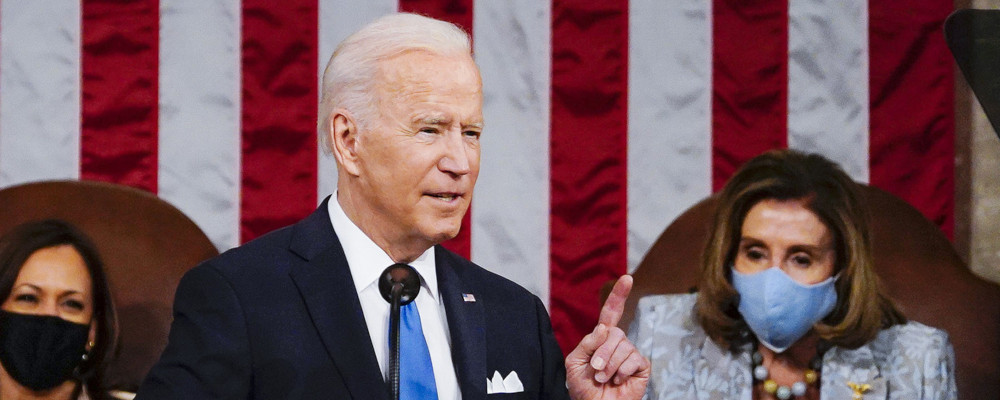The Hub launched with a core mission of getting Canadians thinking about the future. We’ve been stuck in the doldrums, pessimistic and polarized, for too long. To lay out a roadmap for the next 30 years of Canadian life, we asked our contributors to pinpoint the most consequential issue, idea or technology for the country in 2050. This series of essays by leading thinkers will illuminate Canada’s next frontier.
In ordinary times, Canada fares pretty well under the mantra of “peace, order and good government.” But sometimes circumstances demand more of us, and right now we are living in anything but ordinary times.
“I think circumstances have changed drastically. We’re at a genuine inflection point in history. We’ve gotten to a point where I think our economic competence has a gigantic impact on our international influence and capacity,” said United States President Joe Biden said last week in an interview with New York Times Columnist David Brooks, reflecting on the bold agenda of the first months of his presidency.
Back in August, in the midst of the Presidential campaign, I argued that Biden’s election would bring a significant reset on how we think about economic competitiveness and innovation policy.
The policy choices that we make in the coming years will shape the Canada of 2050. The biggest choice, in my view, relates to our policy framework for innovation and competitiveness.
It is crucial that Canada shift its underlying policies to better support technological development and progress if we are to compete in the new highly valuable and highly competitive areas of growth and productivity.
Canada’s export competitiveness has weakened in recent years as its share of the U.S. market declined. USMCA, TPP and CETA notwithstanding, trade has not been a significant source of economic growth for many years. Over the last two decades, Canadian exports have risen at just half the pace of the overall economy.
The production economy of the 20th century is transitioning to an increasingly intangibles economy.
The world is not flat. The Washington Consensus that has shaped domestic economic policies and global institutions in a laissez-faire mold for the last four decades is being challenged by new geo-economic realities. To the chagrin of neoclassical economists who preached free-market orthodoxy, western countries have moved from a laissez-faire approach to a national interest-driven (industrial policy) model focused on key sectors and technologies based on national priorities and competitive advantage.
As a technological juggernaut, China is forcing western governments to redefine their role in adopting strategies to stay on top of innovation in key sectors. Beijing’s “Made in China 2025” strategy is clear: it aspires to make China the world technology-intensive manufacturing powerhouse. It hasn’t gone unnoticed. There is now strong bipartisan support in the U.S to bolster the country’s ability to compete with China.
If anyone doubted the inevitability of R&D, science and technology as the engine of innovation progress, just look to the COVID-19 pandemic. To go from discovery of a deadly new virus to the creation of protective vaccines in less than a year is an unprecedented scientific achievement. The mRNA vaccine and space exploration are only the most recent examples of the required public-private partnership to drive innovation.
While a stable macroeconomic environment is a prerequisite for growth, it is not a sufficient condition of growth. Every country that has had success in advanced industries (innovation, in other words) — the U.S, Germany, South Korea, Taiwan — has embraced some form of industrial strategy.
As the Obama administration Strategy for American Innovation rightly noted: “The true choice in innovation is not between government and no government, but about the right type of government involvement in support of innovations. The private sector should lead on innovation, but in an era of fierce global competition, governments can and should play an important enabling role in supporting private-sector innovation initiatives.”
As the production economy of the 20th century is transitioning to an increasingly intangibles economy, building Canada’s sectoral capabilities in advanced (or innovation) industries is becoming paramount. These industries encompass technology at its broadest and most consequential. Their dynamism is going to be a central component of our economy going forward.
As such, these industries provide the country’s best shot at supporting innovative and sustainable growth. High productivity ensures that the average worker employed in an advanced industry earned a yearly wage nearly 50 percent higher than the average Canadian worker.
Just consider the potential of our ag-food sector. Robotics, AI and genomics are transforming where economic value is being created in the global supply chain. The Netherlands, with a territory roughly half the size of New Brunswick, has become an agri-food powerhouse, using precision farming after significant R&D investments to produce higher crop yields with less space and resources. The same is true in all advanced industries that are fueled by innovation such as biotech and clean technology.
As David Sainsbury argues in his must-read book Windows of Opportunity: “Effective government policies to increase economic growth start from a recognition that innovation is the engine of economic growth; that firms innovate with the help of many other institutions, such as universities, and that public policies can either help or hinder firms innovation activities.”
The Barton and Leroux reports, both commissioned by the current Liberal government, argued Canada needs to double down on its sectoral strengths.
It’s about time we substitute our incremental approach to innovation mostly made of ill-targeted programs that have yielded sub-par outcomes in the past for a higher risk, higher reward approach.
“Public sector leadership is necessary to support R&D, demonstration and the deployment of low-carbon technologies. Combating climate change is the 21st century moonshot,” argued the White House Council of Economic Advisers in a recently released White paper on energy innovation.
While the last federal budget was a missed opportunity on a long-term growth strategy, it’s never too late to do good. President Biden is acting with a sense of urgency: he is moving boldly to counter the rise of China by propelling America to the forefront of the 4th Industrial Revolution.
One could argue this geo-economics shift is overstated, but it is hard to deny we are living through the return of political economy. What really matters now is how we respond to it as a country.
Recommended for You

One reason for our faltering economy? Canada’s struggle to turn innovation into growth

Lucy Hargreaves: Meet Canada’s first AI member of Parliament

Shopify President Harley Finkelstein says Canada must ditch its ‘tall poppy syndrome’ to become a ‘founder nation’

DeepDive: How to build an AI economy that benefits both companies and Canadian workers




Comments (0)